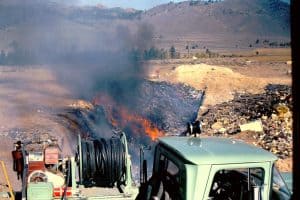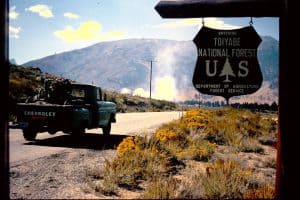I posted a part of this column in another thread. Here’s the entire article, with links. It’s from the February 2023 edition of The Mountain Times, a community newspaper in my area. I write a monthly column, The Woodsman.
FWIW, California is in the midst of a “pinemaggedon.”
“Firmageddon” and Oregon Forest Health
By Steve Wilent
For newspaper, magazine, or blog editors trying to come up with attention-grabbing headlines (as all editors do) for a story about forest health (boring!), using the word “Firmageddon” would be a slam dunk. The Oregonian used the term in a November 25, 2022, article, “Record number of firs dying in Oregon, Washington in what experts call ‘Firmageddon.’” Other newspapers far and wide ran similar headlines, including Esquire, Wired, and the US edition of the British newspaper, The Guardian.
Firmageddon, a term based on “armageddon,” was coined by researchers who had compiled data cleaned from aerial surveys of forest conditions in Oregon and Washington. According to The Oregonian, the researchers found that “Fir trees in Oregon and Washington died in record-breaking numbers in 2022,” and it was “the largest die-off ever recorded for fir trees in the two states.”
Note that the die-off of firs does not include Douglas-fir, the most common tree in our area, but so-called “true fir” species grand fir and noble fir, which are common in the northern Cascades, as well as white fir, Shasta fir, and red fir, which are common in southern Oregon. Douglas-fir is not a true fir.
In assessing the results of aerial surveys covering about 25 million acres in Oregon, the researchers found that “The fir mortality is widespread and quite severe in some locations. Fir mortality has been detected across Oregon and Washington, but the elevated and more severe fir mortality was observed across the Ochoco, Malheur, Fremont, and Winema National Forests from Central Oregon to the California border. More than 1.2 million acres have been impacted with fir mortality across the Pacific Northwest, with ~1.1 million of those acres all being recorded in Oregon. Nearly double the acres impacted compared to all the previous year’s data on fir mortality in Oregon.”
The results of the surveys are summarized in “Forest Health Highlights in Oregon – 2021,” from the Oregon Department of Forestry and the US Forest Service (download it at tinyurl.com/3cmna6hc). The US Forest offers an informative “story map” that looks at data from Oregon and Washington (tinyurl.com/ywy76erh).
Trees die in our forests every year due to a variety of natural causes, such as wildfire, insect attacks, and diseases. In recent years, many trees have been weakened by drought stress, which reduces their ability to defend themselves against insects and diseases. Heat stress, such as during the unusual “heat dome” we all suffered through in 2021, also weakens trees. The graph accompanying this article shows that tree deaths from abiotic factors—drought and heat stress (shown in blue)—were far greater in 2021 than in previous years. This is not surprising, as much of Oregon has seen drought conditions in recent years, “most heavily across Oregon from the center of Oregon around the Ochoco Mountains to the California border,” according to the report.
To me, as a forester, the high mortality in true firs isn’t surprising. In many areas, especially in eastern and southwestern Oregon, true firs have “invaded” forests that had previously been dominated by large, old ponderosa pines and Douglas-firs. In the past, relatively frequent, low-intensity fires killed most of the young true firs before they could become big enough to compete with the larger, older trees. Such fires were caused by lightning or were intentionally lit by Native Americans for centuries before European settlers moved in. Today, the invading true firs have become large enough to compete with larger trees for water and nutrients, and most or all trees in these overcrowded forests are stressed, leaving them more susceptible to insects, diseases, drought, heat waves, and especially wildfire.
The US Forest Service, the Oregon Department of Forestry, private landowners, and other forest managers have worked for many years to reintroduce low-intensity fire—prescribed fire that is beneficial in ways similar to the fires lit by Native Americans. With so many young trees and dead/down woody debris in these forests, wildfires that otherwise would have been low intensity, leaving the largest trees unscathed, often become high-intensity fires that kill many or all of the large trees. Using prescribed fire in these areas can help clear out the invading firs, but only if the amount of available fuel is reduced beforehand through mechanical or hand thinning.
Oregon Forest Facts
The “Forest Health Highlights” report makes for interesting reading for foresters and others who are concerned about die-offs in our forests. For a more general look at forests, see “Oregon Forest Facts, 2023-24 Edition,” from the Oregon Forest Resources Institute, or OFRI (a free download at tinyurl.com/ya9w6hwu. Teachers, take note: OFRI will mail you hard copies at co cost).
This 20-page booklet is packed with information. For example:
- Nearly half of Oregon is forestland. Oregon forests vary by species composition and ownership. There are more than 30 distinct forest types, but Douglas-fir dominates in western Oregon, ponderosa pine in eastern Oregon, and mixed conifers in southwest Oregon. In terms of ownership, the federal government manages 61% of Oregon forests; private owners manage 34%; state and county governments manage 4%; and Native American tribes manage 2%.
- Timber harvest levels from public and private forestlands over the past 20 years have remained relatively stable, although the Great Recession (2007-09) and the collapse of the housing market brought a severe contraction in the U.S. demand for lumber. Consequently, Oregon’s timber harvest reached a modern-era low in 2009, the smallest harvest since the Great Depression in 1934. By 2013, the harvest had rebounded to roughly pre-recession levels.
- Oregon has led the nation for many years in producing softwood lumber and plywood typically used for homebuilding. Oregon’s lumber output of 6.1 billion board feet in 2021 accounted for about 16.5% of total U.S. production, while Oregon plywood mills accounted for about 28% of total U.S. plywood production in 2021.
Oregon also leads the nation in the number of plants that manufacture engineered wood products such as cross-laminated timber (CLT), glue-laminated timber (glulam), and mass plywood panels (MPP). MPP? Think plywood, but huge: Up to 48 feet long, 10 feet wide, and a foot thick. The only MPP manufacturer in the world, so far, is Freres Engineered Wood, in Lyons, Oregon.
Have a question about the trees and plants in our forests? Want to know how much of Oregon is forested now compared to, say, in 1600? Let me know. Email: [email protected]


